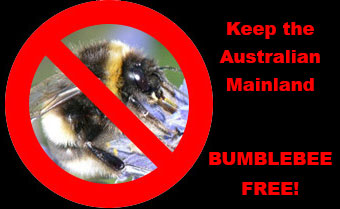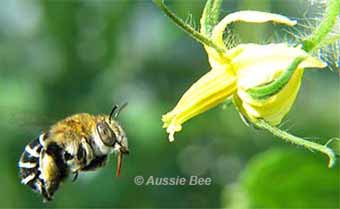SHOULD WE USE EUROPEAN BUMBLEBEES IN AUSTRALIA?
Aussie Bee > Bumblebee Problem
Other Aussie Bee reports on Bumble Bees:
-- How to identify a bumblebee
-- Have you seen a bumblebee on the Australian mainland?
-- What harm could feral bumblebees cause?
-- How far could feral bumblebees spread in Australia
-- Bumblebees and invasive weeds in Australia
-- The native bee alternative to the exotic bumblebee
The Debate Rages...
In many overseas countries, growers use Bumble Bees to pollinate crops such as tomatoes, cucumbers and eggplants, avoiding the cost of manual pollination. However, if Bumble Bees escape and become feral, they can cause serious problems for the natural environment and farms.
Australia has no native species of Bumblebees. So in 1997 and in 2004, horticulturalists applied to import the European Bumblebee, Bombus terrestris, into Australia for crop pollination. Both applications were rejected by the Government because of the major threats that exotic Bumblebees pose to our Australian bushland and agriculture.
Bumblebees are notorious for their ability to escape from crop greenhouses and invade the surrounding countryside. Problems that exotic Bumblebees can cause include:
-- spreading weeds on farms,
-- competing with native bees and birds,
-- reducing seed set in wildflowers, and
-- spreading parasites and pathogens.
Read more about the harm that feral Bumblebees can cause.

Tasmania
Unfortunately a feral population of European Bumblebees was discovered in Tasmania in 1992. These exotic Bumblebees soon spread widely across the state and have now invaded all of Tasmania's vegetation types. Fortunately the Australian mainland is still Bumblebee-Free.
It is currently illegal to use the exotic Bumblebees in Tasmania for crop pollination. However, the tiny greenhouse crop industry there is lobbying for this law to be changed. If successful, their campaign will substantially increase the risk that feral European Bumblebees could be introduced to mainland Australia.
A Native Bee Alternative
Research at the Universities of Western Sydney and Adelaide (Aussie Bee Online Articles 2, 9 and 10, and University of Adelaide research reports) showed that Australian native Blue Banded Bees could be good alternative pollinators to Bumblebees for greenhouse tomato crops.
Aussie Bee's Views on the Bumblebee Debate
Australia has a long history of introducing exotic species (e.g. rabbits, foxes and cane toads) that in later years prove to have substantial negative impacts on the Australian environment!
Aussie Bee strongly opposes the importation of European Bumblebees to Australia and also the commercial use of the feral European Bumblebees in Tasmania.
Instead we urge that Australian native bees, such as Blue Banded Bees, be developed as alternative pollinators for the horticultural industry.
FURTHER INFORMATION
Dafni, A, Kevan, P, Gross, CL, Goka K (2010) Bombus terrestris, pollinator, invasive and pest: an assessment of problems associated with its widespread introductions for commercial purposes. Applied Entomology and Zoology, 45: 101–113.
Read More about the Problem of Bumblebees in Australia:
-- The European Bumble Bee is listed as a Key Threatening Process in NSW.
-- The European Bumble Bee is listed as a Potentially Threatening Process in Victoria.
-- What harm could exotic Bumblebees do in Australia?
-- How to identify a Bumblebee.
-- How to report a Bumblebee sighting on the Australian mainland.
-- How far could feral Bumblebees spread in Australia?
-- Feral Bumblebees and the spread of invasive weeds.
-- The Australian Government has twice rejected plans to import European Bumblebees.
-- Ferals told to buzz off and leave pollination to locals (SMH article).
-- Why the locals are just the bee's knees (Letter to Editor, SMH).
Articles in the media re the second Bumblebee import application
Ferals told to buzz off and leave pollination to locals
by James Woodford
Article originally published in Sydney Morning Herald, 10 May 2003
To native bee or bumblebee? That is the question.
But Melissa Bell says authorities should not even be asking it.
The University of Western Sydney horticulturist is studying the potential of Australian bees to be used for the commercial pollination of crops.
Ms Bell says at least one common species - the spectacular, agile and docile blue-banded bee - could be perfect for the job of glasshouse pollination. Her research has shown that the bees appear to be prolific tomato pollinators, particularly attracted to yellow, blue and purple flowers.
The bees are so absorbed by blue that when Ms Bell is writing her notes the insects follow her pen. Also, unlike honey bees, the blue-banded variety are non-aggressive and virtually have to be squashed before stinging.
However, glasshouse tomato growers are lobbying the Federal Government to allow the introduction of the exotic bumblebee to mainland Australia.
Bumblebees have already been brought to Tasmania illegally.
Ms Bell is racing to prevent the introduction of yet more species of bees from overseas, warning that Australia risks importing another pest.
In the absence of wind, glasshouse growers need a pollinator living with their plants to make them develop seeds and grow properly. The only alternative is to employ people to shake every flower truss.
The European honey bee, which has already spread across Australia, is unsatisfactory because it lacks the ability to "buzz pollinate" - it is physically unable to bury itself in tomato flowers and shake pollen free.
European bees also dislike life indoors and tend to throw themselves against the glass rather than into the flowers.
Blue-banded bees, on the other hand, have extraordinary aeronautical abilities, allowing them to manoeuvre easily through the thickest of vegetation, and they don't mind being kept inside.
Ms Bell's research suggests that they can live happily with a few mud bricks to nest in.
A report funded by Horticulture Australia found that there was little risk to the environment from bumblebees, but some scientists disagree.
A new study says the exotic bumblebees have spread rapidly in the nine years since their introduction to Tasmania.
"Contrary to previous suggestions, the species is established in the most remote parts of Tasmania and is not dependent on introduced garden plants," it says.
"Given their strong record of invasion, it is likely that [bumblebees] will form feral populations on the mainland of Australia . . . Because of their likely negative impacts on native animals and plants, and potential to enhance seed production in weeds, the spread of bumblebees should be avoided."
Ms Bell wants there to be more focus on the skills of the nation's more than 1500 bee species.
"At what risk do we bring in another exotic species? They don't have a pollinator but we have native bees that with more research may do the job."
© 2003 James Woodford. All Rights Reserved. This article is reproduced on this website with the kind permission of the author.
Why the locals are just the bee's knees
Dr Brian Faulkner
Letter to the Editor, Sydney Morning Herald
10 May 2003
I was very pleased to see your story on Melissa Bell and her research on the use of Australian blue-banded bees as potential pollinators of commercial greenhouse tomatoes, in preference to introducing exotic bumblebees ("Ferals told to buzz off and leave pollination to locals", Herald, May 10-11).
In the 1980s I researched the pollination biology of bumblebees at the University of Exeter in Britain. It is true that bumblebees are fantastic pollinators and that overseas they have had a huge impact on production of glasshouse crops.
However, based on my experiences with these exotic bees, I hold great concerns that if bumblebees are introduced into mainland Australia they will establish feral populations which will compete with native fauna and cause significant environmental harm.
I find it particularly frustrating that horticulturists are proposing to bring in exotic bumblebees despite the fact that we have several Australian native bee species that will visit and successfully pollinate tomatoes and other crops.
As researchers are demonstrating, these bees can be raised in glasshouses and used as crop pollinators. What the glasshouse crops industry should be pushing for is more funding for research on native bee species. We certainly don't need any more introductions of exotic species that may threaten our damaged and fragile ecosystems.
Dr Brian Faulkner
Pheasants Nest, NSW
Other Aussie Bee reports on Bumble Bees:
-- How to identify a bumblebee
-- Have you seen a bumblebee on the Australian mainland?
-- What harm could feral bumblebees cause?
-- How far could feral bumblebees spread in Australia
-- Bumblebees and invasive weeds in Australia
-- The native bee alternative to the exotic bumblebee



